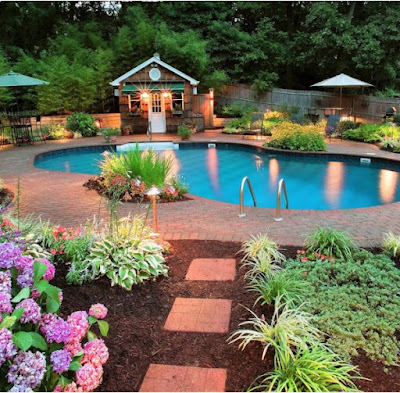Transforming
Introduction
Transforming your outdoor space into a picturesque landscape doesn't have to drain your wallet. With careful planning, creativity, and a bit of DIY spirit, you can achieve a stunning and budget-friendly landscape transformation. In this article, we will explore practical tips and tricks to help you revamp your outdoor area without breaking the bank. Let's dive in!
Plan and Set a Budget
Before you embark on your landscape transformation project, it's essential to have a clear plan in place. Assess your outdoor space and identify areas that require improvement. Determine your budget, taking into consideration any constraints you may have. By setting a budget from the start, you'll be able to prioritize expenses and make informed decisions throughout the process.
Do-It-Yourself (DIY) Projects
One of the most effective ways to save money during a landscape transformation is by taking on do-it-yourself projects. From building raised garden beds to creating a charming pathway, there are countless opportunities to showcase your creativity and save on labor costs. Explore online tutorials, join gardening forums, and tap into your artistic side to bring your vision to life.
Opt for Native Plants
Choosing native plants for your landscape not only helps preserve local biodiversity but also saves you money in the long run. Native plants are well adapted to the local climate, requiring less water, fertilizer, and maintenance compared to exotic species. Visit local nurseries or garden centers to find a variety of affordable native plants that will thrive in your region.
Mulch and Compost
Mulching and composting are budget-friendly practices that provide numerous benefits for your landscape. Mulching helps retain moisture, suppress weed growth, and insulate plant roots, reducing the need for frequent watering and weed control. Composting allows you to recycle kitchen scraps and yard waste, producing nutrient-rich soil amendments for your plants. Both mulch and compost can be obtained at low or no cost from local municipalities or by creating your own compost pile.
Repurpose and Upcycle
Before you head to the store to purchase new items for your landscape, consider repurposing and upcycling materials you already have. Look for unused items such as old containers, furniture, or salvaged materials that can be transformed into unique planters, decorative accents, or seating areas. Not only will this save you money, but it will also add a touch of originality to your landscape.
Prioritize Maintenance
Regular maintenance is crucial for keeping your landscape healthy and vibrant. By implementing a proactive maintenance routine, you can prevent costly problems down the line. Regularly prune plants, remove weeds, and monitor the health of your lawn to ensure optimal growth. Proper maintenance will save you money by avoiding the need for expensive remedies and replacements.
Conclusion
Transforming your outdoor space into a budget-friendly landscape is an achievable goal with the right approach. By planning, prioritizing, and implementing cost-effective strategies such as DIY projects, native plants, mulching, and repurposing, you can revamp your outdoor area without breaking the bank. Remember to set a budget, stay creative, and enjoy the process of creating a beautiful and wallet-friendly landscape that you can take pride in for years to come. Happy gardening!
FAQs (Frequently Asked Questions)
Q1: How much should I budget for a budget-friendly landscape transformation?
A1: The budget for a budget-friendly landscape transformation can vary depending on the size of your outdoor space and the extent of the changes you wish to make. It's important to assess your needs and set a realistic budget that aligns with your financial resources. By planning ahead and prioritizing your expenses, you can create a budget that suits your requirements.
Q2: Can I transform my landscape on a tight budget?
A2: Absolutely! Transforming your landscape on a tight budget is possible with careful planning and resourcefulness. By taking on do-it-yourself projects, choosing affordable native plants, repurposing materials, and practicing cost-saving measures like mulching and composting, you can achieve a beautiful transformation without breaking the bank.
Q3: Where can I find affordable native plants for my landscape?
A3: You can find affordable native plants at local nurseries, garden centers, or botanical societies. These establishments often offer a variety of native plant options that are suitable for your region. Additionally, you can explore community plant swaps, online gardening groups, or even check with local conservation organizations for potential native plant sales or exchanges.
Q4: How can I save money on landscaping materials?
A4: There are several ways to save money on landscaping materials. Firstly, consider repurposing and upcycling materials you already have, such as old containers or salvaged items. You can also check for discounted or clearance sales at local stores or search online marketplaces for affordable deals. Lastly, consider reaching out to construction sites or local businesses to inquire about any unused materials they might be willing to give away or sell at a reduced price.
Q5: Is professional help necessary for a budget-friendly landscape transformation?
A5: While professional help can provide expertise and save time, it's not always necessary for a budget-friendly landscape transformation. Many aspects, such as planting, building small structures, and basic design, can be accomplished through DIY efforts. However, if you require specialized skills or assistance for complex tasks, it may be worth considering hiring professionals on a limited basis while focusing on DIY for other aspects to reduce costs.
Q6: How can I maintain my budget-friendly landscape without overspending?
A6: Proper maintenance is key to ensuring the longevity and health of your budget-friendly landscape. Regularly monitor and address any issues promptly to prevent them from becoming costly problems in the future. Implement a proactive maintenance routine that includes tasks like pruning, weeding, and fertilizing appropriately. By staying on top of maintenance, you can avoid unnecessary expenses and keep your landscape looking beautiful on a budget.




Comments
Post a Comment